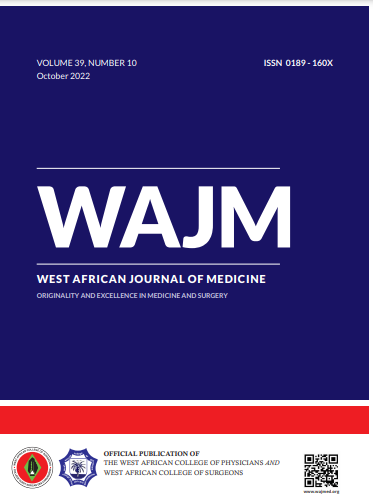ORIGINAL: Anthropometric Indices for Predicting Hypertension among General Outpatient Clinic Attendees of Federal Medical Centre, Bida, Nigeria
West Afr J Med . 2023 Jan 30;40(1):5-10.
Keywords:
BMI; High blood pressure; Waist circumference; Waist-height ratio.Abstract
Abstract in English, FrenchBackground: The literature is replete with overwhelming evidence that being obese is a predictor of hypertension risk. Obesity can be defined by anthropometric indices, such as Body Mass Index (BMI), Waist Circumference (WC), waist-hip ratio (WHR), and waistheight ratio (WHtR). Despite wide use of BMI as indicator of obesity, it does not reflect central fat distribution, whereas WC, WHR, and WHtR are used as surrogate markers for body fat centralization. A central distribution of body fat has been shown to be strongly associated with hypertension. Controversies, however, remain regarding the best predictor of hypertension risk. We determined the prevalence of hypertension and assess its association with the four obesity-related indices above. We evaluated which anthropometric measurement most closely relates to high blood pressure risk among adult patients 18 years and above in Bida.
Methods: This is an analytical cross-sectional hospital-based study of 210 systematic randomly selected adults. Participants were administered a standardized questionnaire and had anthropometric measurements taken along with their blood pressure.
Results: The percentage of people with high blood pressure was 38.6% (33.7% for males and 42.4% for females). WC (p-value <0.001), WHR (p-0.001), WHtR (p-value <0.001) and BMI (p-0.016) were all statistically significantly associated with hypertension. At the multivariate analysis level; waist circumference (OR= 3.635, p= 0.002, CI = 1.613-8.189) and waist-height ratio (OR= 7.183, p-value <0.001, CI = 2.661-19.389) remained strong predictors of hypertension risk. Analysis of the receiver operated characteristics curve showed that waist circumference (0.842) and waist-height ratio (0.838) were the best predictors of hypertension risk.
Conclusion: The central obesity indices WC, and WHtR were better than BMI for the prediction of hypertension in adults >18 years. Therefore, WHtR or WC is recommended as a screening tool for the prediction of hypertension in our clinics, as a means of prevention and early detection of hypertension to halt or slow down the rising burden of hypertension.
Keywords: BMI; High blood pressure; Waist circumference; Waist-height ratio.


